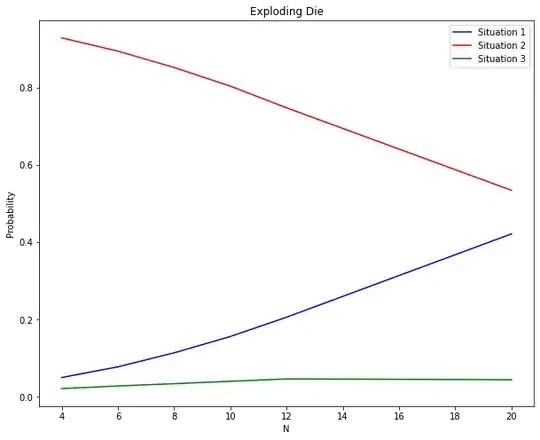For the purposes of simplicity, I am considering 2 variables here:
I will be considering Player to be a person rolling 1dN exploding die, where N can equal 4, 6, 8, 10, 12, 20. With the help of @peterwhy in my previous post (https://math.stackexchange.com/a/4473595/1068076), I was able to come up with the equation $P_1(x,n)=\left \{ (x>0)\wedge (x \textrm{ mod }n>0):\left(\frac{1}{n}\right)^{\left(1+\left \lfloor \left ( \frac{1}{n} \right ) \right \rfloor\right)},0 \right \}$ to calculate the probability of rolling a value $x$ on an $n$-sided exploding die.
I will be considering Dealer to be a person rolling 2d10, both of which can explode. Again, thanks to @peterwhy, the equation $P_2(x,n)=\sum_{i=1}^{x}P_1(i,n)P_1(x-i,n)$ defines the probability of rolling value $x$ on 2 $n$-sided exploding dice. $$$$ I need to calculate the probability of success for 3 different situations involving these variables:
Situation 1 - Success occurs when Player rolls higher than Dealer.
Situation 2 - Success occurs when Player rolls lower than Dealer.
Situation 3 - Success occurs when Player rolls equal to Dealer.
So far, I've been attempting to calculating the probability by using the AND principle ($P(x \textrm{ and } y)=P(x)\cdot P(y) $) using summation equations for $x$ an $y$, but those only gave me the probability of success if the Player rolled that value (but even those didn't work properly because I believe they only calculate the probability of this event occurring). The equations I came up with are as follows: $$\textrm{Situation 1: }P_>(x)=\sum_{i=x}^{100}P_1(i,n)\cdot\sum_{j=0}^{x-1}P_2(j,10)$$ $$\textrm{Situation 2: }P_<(x)=\sum_{i=0}^{x-1}P_1(i,n)\cdot\sum_{j=x}^{100}P_2(j,10)$$ $$\textrm{Situation 3: }P_=(x)=P_1(x,n)\cdot P_2(x, 10)$$
Does anyone know what I can do to find the probability of success for each die and situation?
